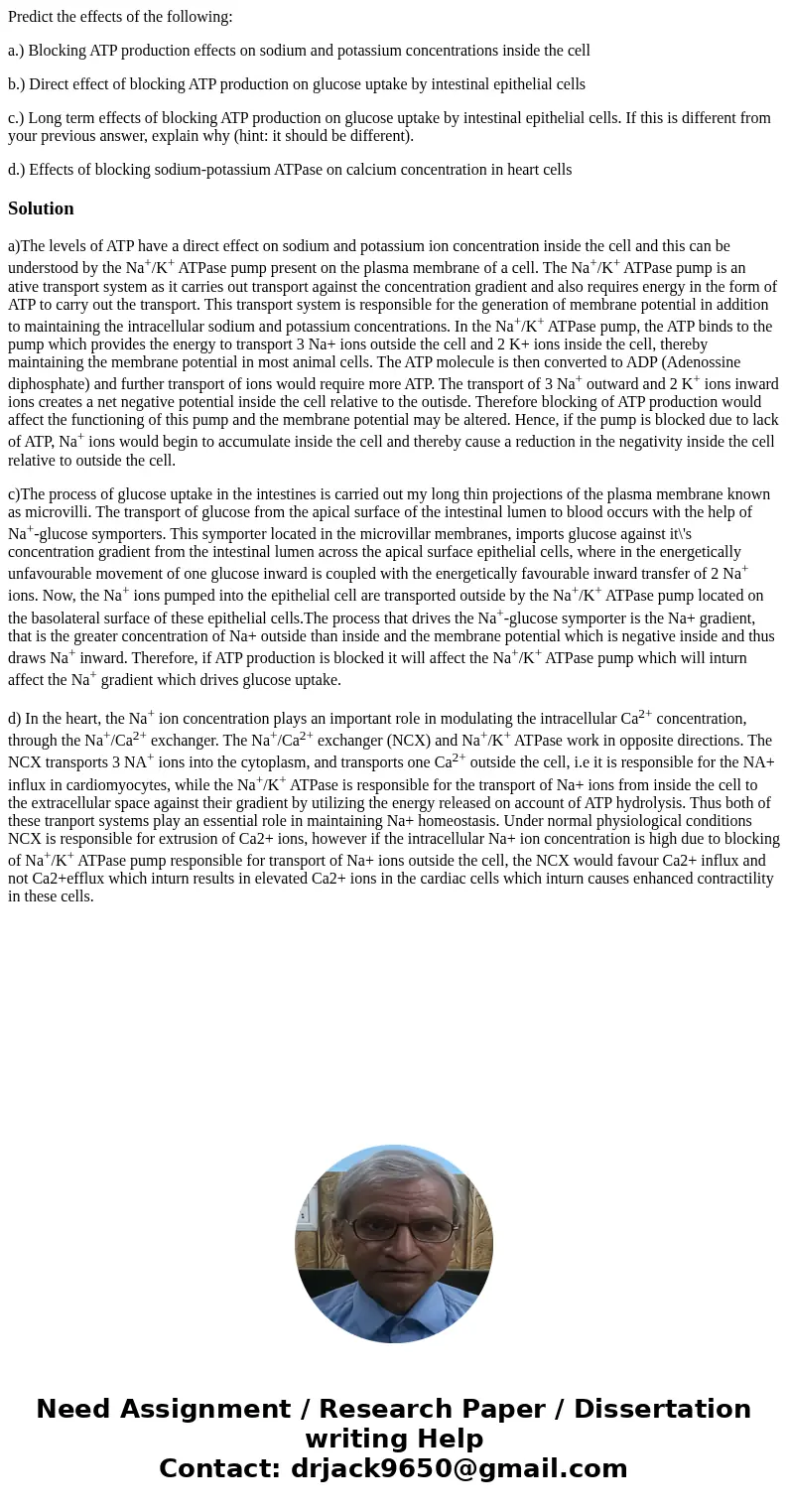Predict the effects of the following a Blocking ATP producti
Predict the effects of the following:
a.) Blocking ATP production effects on sodium and potassium concentrations inside the cell
b.) Direct effect of blocking ATP production on glucose uptake by intestinal epithelial cells
c.) Long term effects of blocking ATP production on glucose uptake by intestinal epithelial cells. If this is different from your previous answer, explain why (hint: it should be different).
d.) Effects of blocking sodium-potassium ATPase on calcium concentration in heart cells
Solution
a)The levels of ATP have a direct effect on sodium and potassium ion concentration inside the cell and this can be understood by the Na+/K+ ATPase pump present on the plasma membrane of a cell. The Na+/K+ ATPase pump is an ative transport system as it carries out transport against the concentration gradient and also requires energy in the form of ATP to carry out the transport. This transport system is responsible for the generation of membrane potential in addition to maintaining the intracellular sodium and potassium concentrations. In the Na+/K+ ATPase pump, the ATP binds to the pump which provides the energy to transport 3 Na+ ions outside the cell and 2 K+ ions inside the cell, thereby maintaining the membrane potential in most animal cells. The ATP molecule is then converted to ADP (Adenossine diphosphate) and further transport of ions would require more ATP. The transport of 3 Na+ outward and 2 K+ ions inward ions creates a net negative potential inside the cell relative to the outisde. Therefore blocking of ATP production would affect the functioning of this pump and the membrane potential may be altered. Hence, if the pump is blocked due to lack of ATP, Na+ ions would begin to accumulate inside the cell and thereby cause a reduction in the negativity inside the cell relative to outside the cell.
c)The process of glucose uptake in the intestines is carried out my long thin projections of the plasma membrane known as microvilli. The transport of glucose from the apical surface of the intestinal lumen to blood occurs with the help of Na+-glucose symporters. This symporter located in the microvillar membranes, imports glucose against it\'s concentration gradient from the intestinal lumen across the apical surface epithelial cells, where in the energetically unfavourable movement of one glucose inward is coupled with the energetically favourable inward transfer of 2 Na+ ions. Now, the Na+ ions pumped into the epithelial cell are transported outside by the Na+/K+ ATPase pump located on the basolateral surface of these epithelial cells.The process that drives the Na+-glucose symporter is the Na+ gradient, that is the greater concentration of Na+ outside than inside and the membrane potential which is negative inside and thus draws Na+ inward. Therefore, if ATP production is blocked it will affect the Na+/K+ ATPase pump which will inturn affect the Na+ gradient which drives glucose uptake.
d) In the heart, the Na+ ion concentration plays an important role in modulating the intracellular Ca2+ concentration, through the Na+/Ca2+ exchanger. The Na+/Ca2+ exchanger (NCX) and Na+/K+ ATPase work in opposite directions. The NCX transports 3 NA+ ions into the cytoplasm, and transports one Ca2+ outside the cell, i.e it is responsible for the NA+ influx in cardiomyocytes, while the Na+/K+ ATPase is responsible for the transport of Na+ ions from inside the cell to the extracellular space against their gradient by utilizing the energy released on account of ATP hydrolysis. Thus both of these tranport systems play an essential role in maintaining Na+ homeostasis. Under normal physiological conditions NCX is responsible for extrusion of Ca2+ ions, however if the intracellular Na+ ion concentration is high due to blocking of Na+/K+ ATPase pump responsible for transport of Na+ ions outside the cell, the NCX would favour Ca2+ influx and not Ca2+efflux which inturn results in elevated Ca2+ ions in the cardiac cells which inturn causes enhanced contractility in these cells.

 Homework Sourse
Homework Sourse